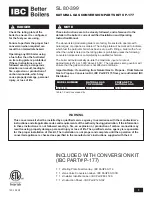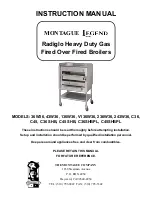
57
Venting the Boiler
5.2 Selecting Vent Pipe Materials
Venting requirements differ in the US and Canada. Consult the
following chart or the most recent edition of ANSI Z223.1/NFPA
54 or CAN/CGA B149.1, as well as all applicable local codes and
regulations when selecting vent pipe materials. Do not use
cellular core PVC (ASTM F891), cellular core CPVC, or Radel®
(polyphenolsulfone) for the exhaust vent.
Locale
Recommended Vent Materials
USA
Ɣ
PVC/CPVC Schedule 40 or 80 (Solid Core)
Ɣ
Approved Polypropylene (PP)
Ɣ
Approved Stainless Steel (SS)
Canada
*
Ɣ
Type BH Special Gas Vent Class IIA (PVC)
Ɣ
Type BH Special Gas Vent Class IIB (CPVC)
Ɣ
Type BH Special Gas Vent Class IIC
(Polypropylene/Stainless Steel)
* For installation in Canada, field-supplied plastic vent piping must comply
with CAN/CGA B149.1 (latest edition) and be certified to the Standard
For Type BH Gas Venting Systems, ULC-S636. Components of this listed
system must not be interchanged with other vent systems or unlisted
pipes or fittings. All plastic components and specified primers and glues
of the certified vent system must be from a single system manufacturer
and must not be intermixed with another system manufacturer’s parts.
The supplied vent connector and vent termination are certified as part of
the boiler.
CAUTION
Ɣ
This boiler has a built-in control to limit the exhaust
temperature to 149°F (65°C). As a result, the boiler can be
vented with Schedule 40 PVC.
Ɣ
In high temperature applications, the exhaust temperature
can exceed 149°F (65°C). In that case, you must use
Schedule 40 or 80 CPVC, Approved Polypropylene, or
Stainless Steel in the USA or Type BH Special Gas Vent Class
IIB (CPVC) or Class IC (Polypropylene/Stainless Steel) that
conforms to ULC-S636 in Canada.
Ɣ
In systems with 3 in vents, if the exhaust temperature
exceeds 149°F (65°C), CPVC pipe (field supplied) must
be used for the first 3 feet of equivalent pipe length. For
systems with 4 in vents, if the exhaust temperature exceeds
149°F (65°C), CPVC pipe (field supplied) must be used for
the first 5 in of equivalent pipe length.
This product is set to use
PVC
as the default vent pipe material. If
you require that return water hotter than 140°F (60°C) to circulate
back to boiler, the DIP switch must be configured (
DIP Switch 2,
switch #8 to ON position
). Otherwise, the boiler will control and
maintain the flue and DHW temperature below 150°F (65°C) and
140°F (60°C) respectively.
Note
Ɣ
When PCB DIP switch 2 #8 is set to Off (factory
default), the boiler does not operate without an
exhaust thermostat installed.
Ɣ
When you set PCB DIP switch 2 #8 to On, ensure
that CPVC, PP, or SS piping is used for exhaust
venting.
1 2 3 4 5 6
O
N
O
N
1 2 3 4 5 6 7
8
The following
polypropylene
vent components are approved for
use with this appliance:
Duravent PolyPro® SW (Rigid)
3PPS-xxx (3”) or 4PPS-xxx(4”)
Duravent PolyPro® (Flexible)
3PPS-FLEXxx (3”)
3PPS-FAM (3” Rigid-to-Flex Male Adapter)
Centrotherm Innoflue® SW (Rigid)
ISxx03xx (3”) or ISxx04xx (4”)
Hart & Cooley Polyflue™ SW (Rigid)
3PF-xx (3”) or 4PF-xx (4”)
Z-Flex Z-DENS SW (Rigid)
2ZD_ (3” or 4”)
The following
stainless steel
vent components are approved for
use with this appliance:
Duravent FasNSeal® (Rigid)
FSA-PVC3 or FSA-PVC4 (3” or 4” PVC to FasN Seal Appliance Adapter)
FSxxxxx03 or FSxxxxx04 (3” or 4”)
Heat Fab Saf-T Vent® EZ Seal
9301PVC or 9401PVC (3” or 4” PVC/CPVC Outlet Boiler Adapter)
93xx or 94xx (3” or 4”)
Summary of Contents for NHB Series
Page 120: ...120 Appendixes 12 6 Component Assembly Diagrams and Part Lists 12 6 1 Case Assembly NFB 301C...
Page 122: ...122 Appendixes 12 6 2 Case Assembly NFB 399C...
Page 124: ...124 Appendixes 12 6 3 Heat Exchanger and Waterway Assembly NFB 301C...
Page 126: ...126 Appendixes 12 6 4 Heat Exchanger and Waterway Assembly NFB 399C...
Page 128: ...128 Appendixes 12 6 5 Combustion Parts Assembly NFB 301C...
Page 131: ...131 Appendixes 12 6 6 Combustion Parts Assembly NFB 399C...
Page 134: ...Memo...
















































